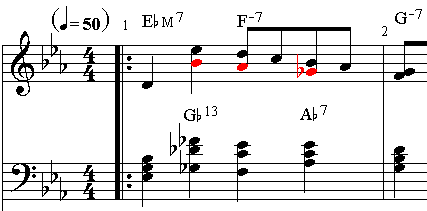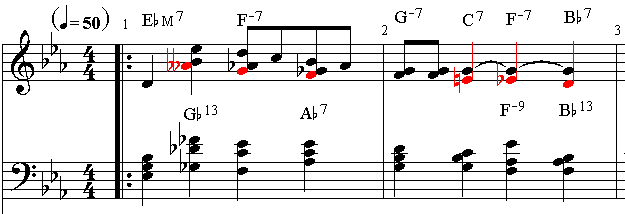I'm rather amazed that I started out to show music theory in arrangements put into action with just a short four measure and we're already up to part 8.
We've focused a considerable amount on the chords and building the chord voicings in the bass clef. This week I'm going to jump back up to the treble clef and walk through the measures and make considerations about changing notes or positions the notes are played in.
I hope you have enjoyed the series so far, because I haven't gotten a lot of comments I'm assuming you are either soaking it up or just completely baffled and are speechless.
Working through measure 1 to 4 adding notes in treble clef.
Starting with where we left on in the last lesson we had finished up with adding chord notes in the first two measures where I used a half step tri-tone substitution into the F-7. We then applied that same idea in measure 3 to modify beats 2 and 3. Here is where we left off the four measures.

This time we can look at each beat as we go and see what additional notes we might add.
In the first beat we have a close structure. Since the D note is beginning lead to the melody line, we want to emphasize it, so I won't make any changes here.
Now beat two offers some potential for adding notes. The bass chord Gb13 ends at F flat (Fb) which is in the treble clef zone. There is a lot of room between the Fb and the high Eb, a major seventh interval away, also known as the 13th interval from the root.
Here's the rule I'm going to use: You can add notes that are in the chord or an extension of the chord (intervals above the 7th) but you can't use any of the notes already used.
Consider the Gb major chord structure using major and minor thirds, the available notes are: Gb – Bb – Db – Fb -Ab – Cb – Eb
I've already used Gb – Db – Fb and Eb that leaves me with Ab – Bb and Cb. So the obvious choice is Bb which is the third of the chord. This fits nicely into the chord as you can see in the next part of the score.

As we move into beat 3 we have a very similar scenario where adding the 3rd again makes sense. Leaving the off beat clean provides a nice melody line to get to beat 4 where I've miss labeled the chord initial because I had the 9th interval, but not the 7th. So I've added it in here.
Notice how the notes we've added here also form a leading line voice within the structure we already have.
As a side note if you study Bach you will find that his preludes are composed of four voices and this type of leading note with the chord structure is what gives his music complexity.
Adding another voice line
Rather than go on to measure two I'm going to push your thought process here. As I was looking at my final arrangement I had added another voice line near these three notes.
So I'm going to push the envelope here and expect to get one of two reactions. One will be what are you doing Brad that's way to much conflict of notes and sounds to crazy. Or, you're going to think that's way cool and I need to do that too!
Explaining this part is going to be a little more difficult and maybe Bob will give us a comment that clarifies what I've done.
The most logical thing I see at this point is that I could use another Gb in the treble clef. However, if I risk using a 9th interval I would get a Ab to Ab from beat 2 to 3. However, I can flat the 9th (Abb- A double flat) and consider that I could also add a 9th interval in the F-7, which is the G, the same note. I can add a lot of color to these chords.

The way I see it is that the Abb is moving to G, that is a flat 9 to a major 9 in the chord structure although we are still using the same note. Also the Bb and Abb of beat two can bring movement to the Ab in the F-7 chord in beat 3. I know this is an odd bit of explanation, but I'm trying to get you to see voice movement in different ways.
It the fourth beat I've added the F (13th) to add that last bit of color and let the last voice line continue as well.
You may want to try both of these on a keyboard (like a 9 foot grand) to hear the difference in sound. Again, I think I'm going to get one of two reactions.
Too finish off this session, I've added another secondary voice line in measure 2. Take the time to figure out what the chord notes these are. In beat three we have a duplicate note, how would you change the chord notes in the bass to fit?
Apply this strategy to measure 3 around the D note and see what you come up with. Next time we'll review that and the whole process. I'll practice up a bit and add some audio so you can hear some of the changes. Just maybe I'll get my entire arrangement practiced up for Christmas eve posting. I might need some encouragement so let me know what you think!
If you like what you've seen, share it on your social pages, see below.
Stay tuned,
Wow, your stuff is excellent. Clear presentation. Not cluttered with extraneous notions. I just discovered your material today and want to thank you for your efforts.
If you have more material I’d be happy to know.
Thanks again,
Pete in Grand Forks, British Columbia.
You can visit our Product Theory site at Music Theory Workshop